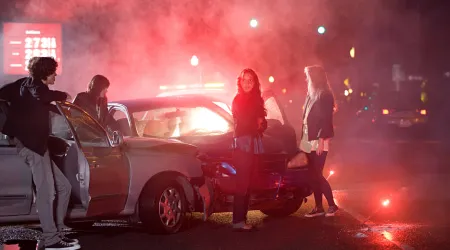Get the cheapest quotes for your car
Compare providers in your area.
Your information is secure
Compare providers in your area.
Your information is secure
Don’t like how much you’re paying for car insurance? There’s one surefire way to pay less: Get older. Did you know that people ages 56 and older pay an average of $4,492 less in premiums each year than someone younger than 18?
If you’re wondering how and why your age affects car insurance, compare car insurance rates by age to find out how much the “youth tax” could cost you.
Then, check out how those rates compare to car accident statistics for different ages. After all, the fewer car accidents you have, the less car insurance companies have to charge you to make a profit.
Age is a top factor that insurers look at when deciding how much you’ll spend on car insurance every year. The reason young people pay more for car insurance is that they’re less experienced and more likely to get involved in a car accident than people older than 26. The good news is that it all gets better with age.
| Age | Average car insurance premium |
|---|---|
Under 18 | $6,932 |
18-21 | $3,858 |
22-25 | $2,819 |
26-30 | $2,555 |
31-35 | $2,541 |
36-45 | $2,592 |
46-55 | $2,465 |
56+ | $2,440 |
Drivers over 55 pay the lowest annual premiums at an average of $2,440. However, drivers between the ages of 26 and 45 have access to the lowest minimum rates of any group — between $596 and $601 a year.
Those rates vary depending on your insurance company. Our research found that Allstate is cheapest for drivers younger than 21, while Travelers offers most other age groups the cheapest coverage. If you’re planning to add a young driver to your policy, you might be better off with Allstate.
Once you hit 18, you could save a whopping $3,074 on average for a standalone car insurance policy. The bad news is that you’ll still pay about $3,858 a year. Your next price drop for car insurance comes between the ages of 22 and 25, where you’ll save another $1,039 in premiums.
Experience combined with driving record tells insurance companies a compelling story about how safe of a driver you are. You’re less likely to get in an accident as you get older since age and experience go hand in hand.
By sheer numbers, 21- to 25-year-olds see the highest number of car accidents, both nonfatal and fatal. This age group averages nearly 1.5 million nonfatal accidents and 5,900 fatal accidents per year. Following, 16- to 20-year-olds see the second-highest number of nonfatal crashes at 1.3 million per year. Meanwhile, for fatal crashes, 26- to 30-year-olds come in second with about 5,000 fatal crashes per year.
We sourced these car accident statistics from the National Highway Traffic Safety Administration (NHTSA), looking at data from 2010 to 2019.
| Age group | Drivers in nonfatal car accidents | Drivers in fatal car accidents |
|---|---|---|
16-20 | 13,256,660 | 41,798 |
21-25 | 14,809,668 | 59,208 |
26-30 | 12,178,214 | 50,896 |
31-35 | 10,586,970 | 43,146 |
36-40 | 9,364,754 | 38,620 |
41-45 | 8,880,663 | 37,440 |
46-50 | 8,647,421 | 38,489 |
51-55 | 8,090,204 | 38,648 |
56-60 | 7,034,363 | 34,580 |
61-65 | 5,281,439 | 26,879 |
66-70 | 3,766,638 | 19,906 |
71-75 | 2,441,364 | 14,482 |
76-80 | 1,615,852 | 10,987 |
As a common theme, 21- to 25-year-olds bring the most speeding-related car accidents of any age group. This age category is followed by 26- to 30-year-olds who also tend to drive above the speed limit.
However, accidents caused by zooming around town decline sharply for drivers over age 35.
| Age group | Drivers in nonfatal speeding accidents | Drivers in fatal speeding accidents |
|---|---|---|
16-20 | 1,580,518 | 12,626 |
21-25 | 2,097,448 | 21,209 |
26-30 | 1,604,749 | 16,805 |
31-35 | 1,337,323 | 13,386 |
36-40 | 1,164,339 | 11,259 |
41-45 | 1,101,315 | 10,211 |
46-50 | 1,042,091 | 9,931 |
51-55 | 889,027 | 9,247 |
56-60 | 728,610 | 7,631 |
61-65 | 527,000 | 5,503 |
66-70 | 150,951 | 1,784 |
71-75 | 210,400 | 2,387 |
76-80 | 63,733 | 805 |
By no surprise, 21- to 25-year-old drivers cause the most drunk driving fatalities compared to other ages. This group causes 2,187 fatal drunk driving accidents every year.
Coming in at a close second, 1,825 drivers from ages 26 to 30 are involved in deadly drunk driving accidents each year.
However, what’s most surprising is the 9,820 drivers under the legal drinking age who also get into fatal car accidents.
| Age group | Drivers involved in fatal drunk driving accidents |
|---|---|
16-20 | 9820 |
21-25 | 21871 |
26-30 | 18253 |
31-35 | 14779 |
36-40 | 12539 |
41-45 | 11371 |
46-50 | 11243 |
51-55 | 10378 |
56-60 | 8227 |
61-65 | 5426 |
66-70 | 3278 |
71-75 | 1979 |
76-80 | 1232 |
It turns out that buckling up isn’t second nature to everyone. Over 47% more 21- to 25-year-old drivers get thrown from their vehicles in nonfatal crashes than any other age. In fatal crashes, over 31% more 21- to 25-year-old drivers get thrown from vehicles over other ages.
Getting ejected from a vehicle can happen when a driver or passenger doesn’t wear a seatbelt. We looked at the number of drivers ejected in this case.
| Age group | Drivers ejected from vehicle, nonfatal | Drivers ejected from vehicle, fatal |
|---|---|---|
16-20 | 15694 | 5179 |
21-25 | 23113 | 7577 |
26-30 | 15535 | 5778 |
31-35 | 13244 | 4569 |
36-40 | 8135 | 3742 |
41-45 | 9283 | 3330 |
46-50 | 6968 | 3177 |
51-55 | 7488 | 2962 |
56-60 | 6435 | 2385 |
61-65 | 3892 | 1694 |
66-70 | 2642 | 1213 |
71-75 | 1825 | 825 |
76-80 | – | 548 |
Across all collision types, 21- to 25-year-old drivers experience each type of collision the most.
For fatal accidents, collisions that don’t involve other moving vehicles are most common. 21- to 25-year-olds are involved in this fatal crash over 25% more than other ages.
For non-fatal accidents, rear-end collisions are the most common. Here again, 21- to 25-year-olds most often end up in this fender bender.
Thankfully, numbers for all types of accidents start dropping off when drivers turn 36.
Age group | Angle | Head-on | Rear-end | Sideswipe | Other/unknown |
|---|---|---|---|---|---|
16-20 | 11236 | 5416 | 2889 | 1511 | 250 |
21-25 | 13775 | 7750 | 5569 | 2303 | 439 |
26-30 | 12111 | 7263 | 5435 | 2148 | 380 |
31-35 | 10208 | 6413 | 5101 | 1997 | 355 |
36-40 | 9358 | 5625 | 4697 | 1821 | 312 |
41-45 | 9361 | 5505 | 4726 | 1921 | 374 |
46-50 | 9290 | 5743 | 4951 | 1939 | 328 |
51-55 | 9552 | 5815 | 4887 | 1900 | 379 |
56-60 | 8954 | 5225 | 4315 | 1724 | 281 |
61-65 | 7087 | 3979 | 3204 | 1276 | 221 |
66-70 | 5660 | 3037 | 2159 | 916 | 143 |
71-75 | 4663 | 2232 | 1382 | 611 | 88 |
76-80 | 4047 | 1565 | 973 | 417 | 75 |
| Age group | Angle | Head-on | Rear-end | Sideswipe | Other/unknown | Not collision with motor vehicle in transport |
|---|---|---|---|---|---|---|
16-20 | 3,371,844 | 390,263 | 5,202,551 | 1,369,015 | 174,382 | 2,748,605 |
21-25 | 3,616,379 | 409,165 | 5,878,161 | 1,748,056 | 222,395 | 2,935,512 |
26-30 | 2,948,315 | 335,614 | 4,972,458 | 1,561,891 | 193,742 | 2,166,195 |
31-35 | 2,492,195 | 274,802 | 4,407,094 | 1,396,330 | 197,873 | 1,818,676 |
36-40 | 2,225,288 | 250,534 | 3,920,367 | 1,245,412 | 175,095 | 1,548,059 |
41-45 | 2,080,119 | 221,985 | 3,731,984 | 1,241,904 | 173,893 | 1,430,780 |
46-50 | 2,028,184 | 224,229 | 3,641,691 | 1,218,917 | 168,970 | 1,365,430 |
51-55 | 1,951,797 | 212,991 | 3,302,070 | 1,159,271 | 164,031 | 1,300,044 |
56-60 | 1,737,640 | 183,796 | 2,801,296 | 1,056,920 | 141,997 | 1,112,715 |
61-65 | 1,397,660 | 140,832 | 2,055,541 | 760,523 | 116,378 | 810,504 |
66-70 | 1,061,712 | 105,539 | 1,384,637 | 568,704 | 80,415 | 565,632 |
71-75 | 758,432 | 77,521 | 834,775 | 364,131 | 57,939 | 348,567 |
76-80 | 550,035 | 53,300 | 504,650 | 239,322 | 36,780 | 231,765 |
Contrary to popular belief, most people get into car accidents during the day, especially nonfatal accidents. In fact, drivers across most ages experience nonfatal crashes two to three times more during the day than at night.
However, fatal accidents are a different story. Drivers from ages 16 to 35 get into fatal accidents most often at night. Around age 36 is when the numbers switch to more fatalities during the day versus night.
| Age group | Day | Night | Unknown |
|---|---|---|---|
16-20 | 19,227 | 22,365 | 206 |
21-25 | 23,556 | 35,331 | 321 |
26-30 | 22,207 | 28,408 | 281 |
31-35 | 20,374 | 22,574 | 198 |
36-40 | 19,286 | 19,157 | 177 |
41-45 | 19,638 | 17,648 | 154 |
46-50 | 20,931 | 17,391 | 167 |
51-55 | 22,101 | 16,380 | 167 |
56-60 | 20,978 | 13,446 | 156 |
61-65 | 17,378 | 9,376 | 125 |
66-70 | 13,794 | 6,021 | 91 |
71-75 | 10,639 | 3,788 | 55 |
76-80 | 8,614 | 2,327 | 46 |
| Age group | Day | Night |
|---|---|---|
16-20 | 9,106,331 | 4,150,329 |
21-25 | 10,005,780 | 4,803,888 |
26-30 | 8,542,022 | 3,636,192 |
31-35 | 7,641,644 | 2,945,326 |
36-40 | 6,898,078 | 2,466,676 |
41-45 | 6,578,599 | 2,302,065 |
46-50 | 6,471,483 | 2,175,938 |
51-55 | 6,113,447 | 1,976,758 |
56-60 | 5,422,404 | 1,611,959 |
61-65 | 4,183,690 | 1,980,760 |
66-70 | 3,033,281 | 733,356 |
71-75 | 2,015,887 | 425,477 |
76-80 | 1,358,883 | 256,969 |
Friday stands as the worst day for car accidents across most age groups. However, on any day of the week, 21- to 25-year-olds see the most car accidents of any age.
The disparity between this group and other ages is the greatest on Saturday. On Saturdays, 21- to 25-year-olds get in an average of 192,000 accidents per year, over 15% more than other ages.
| Age group | Sunday | Monday | Tuesday | Wednesday | Thursday | Friday | Saturday |
|---|---|---|---|---|---|---|---|
16-20 | 1,374,899 | 1,875,972 | 1,989,810 | 2,005,898 | 2,033,460 | 2,349,892 | 1,668,527 |
21-25 | 1,600,230 | 2,125,485 | 2,208,165 | 2,236,494 | 2,227,802 | 2,547,055 | 1,923,645 |
26-30 | 1,229,649 | 1,759,788 | 1,861,814 | 1,871,799 | 1,906,600 | 2,107,329 | 1,492,130 |
31-35 | 986,127 | 1,572,722 | 1,672,513 | 1,648,406 | 1,658,793 | 1,832,560 | 1,258,994 |
36-40 | 840,844 | 1,415,903 | 1,493,041 | 1,452,908 | 1,490,602 | 1,616,338 | 1,093,740 |
41-45 | 794,714 | 1,314,292 | 1,431,313 | 1,415,067 | 1,393,945 | 1,521,409 | 1,047,365 |
46-50 | 751,308 | 1,300,782 | 1,370,022 | 1,371,284 | 1,370,835 | 1,500,404 | 1,021,355 |
51-55 | 691,249 | 1,220,013 | 1,303,654 | 1,252,177 | 1,307,287 | 1,397,738 | 956,732 |
56-60 | 590,679 | 1,062,063 | 1,151,195 | 1,132,172 | 1,105,404 | 1,205,818 | 821,611 |
61-65 | 439,478 | 799,718 | 847,161 | 831,380 | 849,347 | 924,992 | 616,241 |
66-70 | 326,760 | 560,709 | 592,833 | 594,197 | 607,228 | 649,793 | 455,022 |
71-75 | 212,031 | 349,659 | 387,602 | 395,239 | 408,886 | 431,391 | 271,038 |
76-80 | 144,598 | 255,580 | 260,384 | 251,141 | 266,544 | 266,018 | 182,573 |
The reason older drivers pay less on average for insurance — leaving younger drivers ages 18 to 22 to pay some 50% more on premiums — comes down to statistics.
According to the Insurance Institute for Highway Safety, drivers between the ages of 16 and 19 are three times more likely to be involved in a fatal accident than those older than 20. Young drivers are also less experienced and more likely to speed.
All of this informs why insurers charge those younger than 18 over 50% more than someone between the ages of 18 and 22. But what can you do to spare your wallet if you’re younger than 18?
While getting older saves you money on car insurance, cut down on the cost of premiums at any age by comparing your options. And when shopping around for car insurance, keep an eye out for discounts that include:

From knowing how much you have in savings to understanding the tax implications that come with investing.
Read more…
You have so many banking options, so make sure yours offers the strongest perks.
Read more…
Find out which holiday is the deadliest traffic day in the US.
Read more…
From buying tigers to cancelling car insurance, Finder shares a deep dive into 21 Google search terms that changed with coronavirus at the wheel.
Read more…
Stats on the digital economy to keep you in the know.
Read more…
Finder.com analysis of data from WHO, Global Health Expenditure database and the OECD Health Statistics to determine healthcare costs by country.
Read more…
Five services delivering a monthly fashion fix straight to your door. Hit the refresh button on your closet without ever leaving your house.
Read more…
Finder asked 12 financial experts to share their advice on maximizing cashback rewards.
Read more…
Finder research reveals that 65 million Americans will be traveling for Thanksgiving in 2019. Find out which generation is most likely to hit the road and when.
Read more…
8% of American adults have an online bank account, and that figure is expected to hit 11% by 2023 and 11% by the year 2027.
Read more…
Richard Laycock, Insights editor and senior content marketing manager
Some of the top auto insurance providers for single moms and dads to save on options without dropping coverage.
Purchase basic to premium plans for car-sharing. Take home more pay the less Turo covers.
Check out the top 50 American car models, and find out what makes them American.
Does your city or state rank on these foreboding lists?
What to expect with coverage and rates. Plus, how to save even without a license.
Leaving a child in the car could be illegal in your state. But breaking them out could cause you more trouble than you think.
Compare the best short term car insurance policies for monthly, six-month and temporary car insurance coverage.
Compare Toyota insurance rates and quotes, learn how insurance companies determine your rates and how to lower your coverage costs.
Read on to learn more about Subaru insurance rates, and ways to keep your coverage costs down.
Compare insurance rates for BMW models.